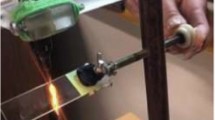Abstract
Although microfluidic devices offer many benefits, high fluid shear stresses in such devices are an undesirable consequence of miniaturization. In the present study, we present an adaptive “smart” design that mitigates the effects of high shear stresses in microfluidic-based devices by autonomously optimizing its internal flow structure. This concept was demonstrated by testing a prototype microscale thermal-fluid device that responded to changes in the local thermal environment. The autonomous, self-optimizing functionality was achieved using poly(N-isopropylacrylamide) hydrogel actuated microvalves, which independently controlled the flow to four distinct regions within the device. The experimental results showed that the device optimized its internal topological flow arrangement such that fluid was delivered only to regions where cooling was required. As a result, a series of spatially distributed thermal loads were dissipated with minimal pumping power consumption.








Similar content being viewed by others
References
Baldi A, Yuandong G, Loftness PE, Siegel RA, Ziaie B (2003) A hydrogel-actuated environmentally sensitive microvalve for active flow control. J Microelectromech Syst 12(5):613–621
Beebe DJ, Moore JS, Bauer JM, Yu Q, Liu RH, Devadoss C, Jo BH (2000) Functional hydrogel structures for autonomous flow control inside microfluidic channels. Nature 404(6778):588–590
Bejan A (2000) Shape and structure, from engineering to nature. Cambridge University Press, Cambridge
Bejan A, Errera MR (2000) Convective trees of fluid channels for volumetric cooling. Int J Heat Mass Transfer 43(17):3105–3118
Cao X, Lai S, Lee LJ (2001) Design of a self-regulated drug delivery device. Biomed Microdevices 3(2):109–118
Champagne PR, Bergles AE (2001) Development and testing of a novel, variable-roughness technique to enhance, on demand, heat transfer in a single-phase heat exchanger. J Enhanc Heat Transf 8(5):341–352
Coleman HW, Steele WG (1999) Experimentation and uncertainty analysis for engineers, 2nd edn. Wiley, New York
Dong L, Jiang H (2007) Autonomous microfluidics with stimuli-responsive hydrogels. Soft Matter 3(10):1223–1230
Eddington DT, Liu RH, Moore JS, Beebe DJ (2001) An organic self-regulating microfluidic system. Lab Chip 1(2):96–99
Garimella SV (2006) Advances in mesoscale thermal management technologies for microelectronics. Microelectron J 37(11):1165–1185
Gerlach G, Arndt KF (2009) Hydrogel sensors and actuators. Springer, New York
Harmon ME, Tang M, Frank CW (2003) A microfluidic actuator based on thermoresponsive hydrogels. Polymer 44(16):4547–4556
Hart RA, da Silva AK (2011) Experimental thermal–hydraulic evaluation of constructal microfluidic structures under fully constrained conditions. Int J Heat Mass Transfer 54(15–16):3661–3671
Hart RA, Ponkala MJV, da Silva AK (2011) Development and testing of a constructal microchannel flow system with dynamically controlled complexity. Int J Heat Mass Transfer 54(25–26):5470–5480
Hoffmann J, Plötner M, Kuckling D, Fischer W-J (1999) Photopatterning of thermally sensitive hydrogels useful for microactuators. Sens Actuators A 77(2):139–144
Kellogg DL (2006) In vivo mechanisms of cutaneous vasodilation and vasoconstriction in humans during thermoregulatory challenges. J Appl Physiol 100(5):1709–1718
Liu RH, Yu Q, Beebe DJ (2002) Fabrication and characterization of hydrogel-based microvalves. J Microelectromech Syst 11(1):45–53
Lorente S, Wechsatol W, Bejan A (2002) Tree-shaped flow structures designed by minimizing path lengths. Int J Heat Mass Transfer 45(16):3299–3312
Meijer GI (2010) Cooling energy-hungry data centers. Science 328(5976):318–319
Nguyen N-T, Wereley ST (2006) Fundamentals and applications of microfluidics, 2nd edn. Artech House, Boston
O’Hayre R, Cha S-W, Colella W, Prinz FB (2005) Fuel cell fundamentals. Wiley, Hoboken
Qu W, Mudawar I (2002) Experimental and numerical study of pressure drop and heat transfer in a single-phase micro-channel heat sink. Int J Heat Mass Transfer 45(12):2549–2565
Richter A, Kuckling D, Howitz S, Thomas G, Arndt KF (2003) Electronically controllable microvalves based on smart hydrogels: magnitudes and potential applications. J Microelectromech Syst 12(5):748–753
Sobhan CB, Garimella SV (2001) A Comparative analysis of studies on heat transfer and fluid flow in microchannels. Microscale Thermophys Eng 5(4):293–311
Tuckerman DB, Pease RFW (1981) High-performance heat sinking for VLSI. IEEE Electron Device Lett EDL-2 5:126–129
van der Linden HJ, Herber S, Olthuis W, Bergveld P (2003) Stimulus-sensitive hydrogels and their applications in chemical (micro)analysis. Analyst 128(4):325–331
Ward JH, Bashir R, Peppas NA (2001) Micropatterning of biomedical polymer surfaces by novel UV polymerization techniques. J Biomed Mater Res 56(3):351–360
Wechsatol W, Lorente S, Bejan A (2002) Optimal tree-shaped networks for fluid flow in a disc-shaped body. Int J Heat Mass Transfer 45(25):4911–4924
Whitesides GM (2006) The origins and the future of microfluidics. Nature 442(7101):368–373
Yu C, Mutlu S, Selvaganapathy P, Mastrangelo CH, Svec F, Fréchet JMJ (2003) Flow control valves for analytical microfluidic chips without mechanical parts based on thermally responsive monolithic polymers. Anal Chem 75(8):1958–1961
Zhao B, Moore JS (2001) Fast pH- and ionic strength-responsive hydrogels in microchannels. Langmuir 17(16):4758–4763
Acknowledgments
We gratefully acknowledge NSF for supporting this work through CAREER Award #846318. We also thank Prof. C. Bielawski and Dr. J. Geng of the UT Austin Chemistry Department for their technical assistance.
Author information
Authors and Affiliations
Corresponding author
Electronic supplementary material
Below is the link to the electronic supplementary material.
Rights and permissions
About this article
Cite this article
Hart, R.A., da Silva, A.K. Self-optimizing, thermally adaptive microfluidic flow structures. Microfluid Nanofluid 14, 121–132 (2013). https://doi.org/10.1007/s10404-012-1030-7
Received:
Accepted:
Published:
Issue Date:
DOI: https://doi.org/10.1007/s10404-012-1030-7




